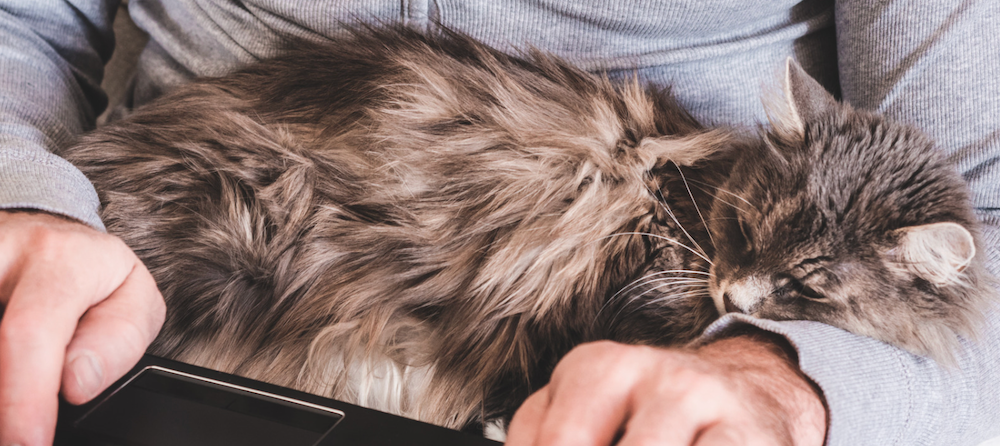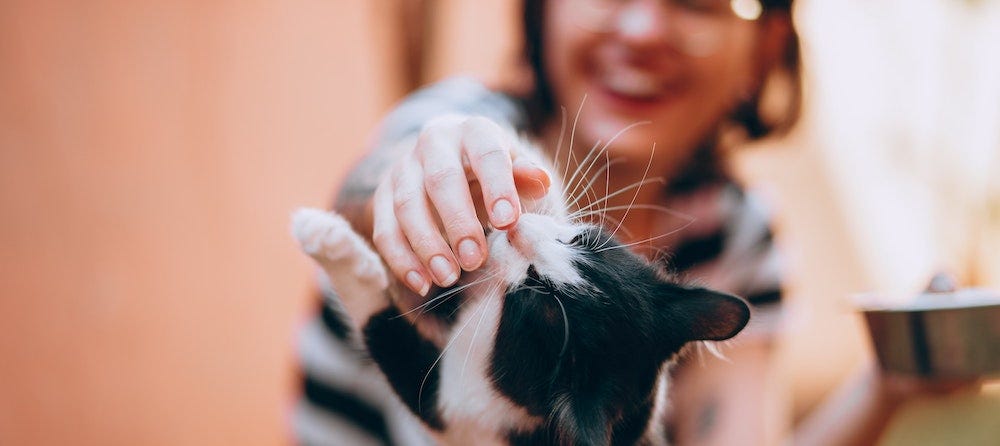April is National Pet First Aid Awareness Month. If you’re putting together your own first aid kit or disaster preparedness kit, why not create one for your pet, too? We’ll review which items should be in your cat first aid kit, including those that fall under categories like bandages, tools, pest care, wound care, medications, and more.
Items you need for a cat first aid kit
The list below isn’t necessarily exhaustive, but it’s a great start for organizing your cat first aid kit. To be especially prepared, you may want to have one kit for home and one for travel (with travel-sized bottles and so on).

Wound care
It’s scary to find your pet bleeding or with open wounds; but with a few simple items, you can take care of most minor injuries without even needing to visit the vet. (However, we do recommend making a trip to the vet if you are uncertain.)
- Sterile saline wound wash to clean wounds without stinging or burning.
- Sterile saline eye wash to clean debris or smoke from your cat’s eyes.
- Styptic gel or powder to stop minor bleeding and clot wounds.
- Water to flush wounds, soothe burns, wash off toxins, soak a paw, cool down, and/or rehydrate your cat!
- NEVER use hydrogen peroxide on your cat’s wounds, as it can slow healing and damage skin cells.
Bandages
Various types of bandages may be needed to protect your cat after treating a wound.
- Gauze pads/sponges to clean wounds and act as a primary layer in a bandage when you aren’t worried about the first covering sticking to the wound or skin.
- Non-stick gauze pads/sponges to cover and bandage burns, cuts, and other wounds.
- Cotton balls and q-tips for cleaning wounds and gently cleaning around ears and eyes (never stick a q-tip or swab into your cat’s ears and eyes).
- Self-adhesive wrap to use as an outer layer for bandages to help keep your bandage in place.
- Bandage tape (1’’-2’’) to hold the different layers of a bandage in place while applying the subsequent bandage layers.
- Duct tape to hold temporary wraps or splints.

Tools
You’ll want a few tools in your cat first aid kit to help with administering medication, treating injuries, and gauging your cat’s health.
- Bandage scissors to cut tape, gauze, splints, or any other type of bandaging material.
- Dosing syringes to administer oral medications and clean or flush wounds.
- Moldable splints to minimize movement in your cat’s injured leg.
- Digital thermometer to check your cat’s temperature (normal range for cats is 99.5-102.5°F).
- Petroleum- or water-based lubricant for taking your cat’s temperature rectally.
Medications
Note that many human medications are not safe for cats—check with your vet before giving your cat any human meds. The medications listed below are typically safe for cats, but it’s best to check with your vet anyway.
- Diphenhydramine/Benadryl to treat mild allergic reactions. Make sure the medication only has diphenhydramine as the active ingredient and is not combined with pain relievers, decongestants, etc. Calculate your cat’s dosage here.
- Sugar tablets to help a diabetic cat or a cat with low blood sugar.
- Extra prescription medication, if your cat is on any.
- Again, never use hydrogen peroxide on cats, either to clean wounds or induce vomiting; we also don’t recommend that cat parents use activated charcoal on cats unless medically trained to do so. If you think your cat has been poisoned, get to an emergency vet ASAP.

Pest care
For those times your cat gets bothered by unwanted critters, you should have a few common household items around.
- Tick removal tool to safely remove ticks and reduce risk of disease. (You can also use tweezers to remove ticks, but they are not as effective.)
- Old credit card or driver’s license card to remove bee and wasp stingers by scraping the stinger away from the direction that it came in. (Tweezers are not as effective here because they can squeeze the venom sack and worsen the reaction and resulting pain.)
- Dawn dish soap to gently treat a severe infestation of fleas in kittens or remove toxins from skin and fur.
Restraints
If your cat is in pain, they may also be panicked and difficult to restrain. Keep a few of these items on hand to help:
- Blanket to wrap up your cat for restraint or comfort.
- Pillow case or mesh bag to use as a makeshift cat carrier in a pinch.
- Nylon muzzle to prevent your cat from biting while you administer first aid.
- Cone collar to prevent your cat from licking or scratching wounds.
- Cat booties to prevent your cat from scratching wounds or chewing off bandages on paws.
Miscellaneous
Finally, you’ll want a few items in your cat first aid kit that don’t fall into any particular category.
- Emergency contact card to have phone numbers for the nearby animal hospital, veterinarian, local police, or pet poison helpline.
- Disposable gloves to protect your hands and protect your cat’s wounds from getting contaminated.
- Collapsible bowl to hold water or mix/dilute disinfectants.
- Extra water and treats to keep your cat hydrated and happy.
Creating a cat first aid kit may seem excessive to some pet parents, but you’ll be very happy to have one on hand if the day ever comes where your cat has been injured. We sincerely hope that this never happens—but there’s no harm in being prepared!
Sources:
Cover photo by Ramiz Dedaković on Unsplash









